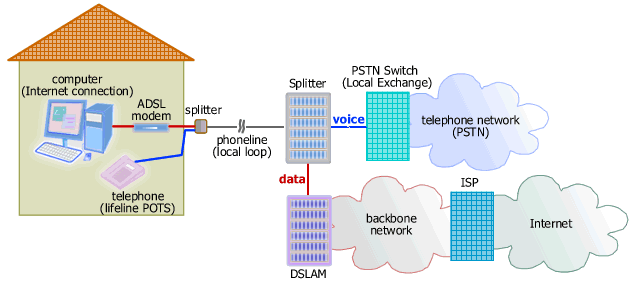Internet Access Guide : ADSL

Picture: ADSL network
An ADSL modem
at a subscriber site communicates with
the corresponding modem at the
nearest operator
site.
ADSL or Asymmetric Digital Subscriber Line is a type of copper
cable enhancement technology (DSL) that delivers Internet traffic at different
rates from the network to the user (downstream) and from the user to
the network (upstream). ADSL uses existing telephone line to carry
voice and data (Internet) signals simultaneously. But
since data signal occupies higher frequencies in the
telephone line spectrum, it doesn't disturb the
telephone service.
To create ADSL, there must be a pair of ADSL
modems, one at the subscriber site and the other at the network operator
site (i.e. Central Office or nearest access node). During an
Internet connection, the two ADSL modems communicates, converting
signal to a format that can be transferred over telephone line. DSLAM (Digital Subscriber Line Access Multiplexer) is a
device at the operator site that contains ADSL modems and
interfaces to backbone network.
ADSL signal from each subscriber is split into voice and data
signals by a splitter (filter) that's usually contained in the
same rack with the DSLAM. The voice (telephone) signal is forwarded
to a telephone switch (Local Exchange) for further connection to
the telephone network (PSTN).
The data signal that carries Internet traffic is sent to the ISP
over backbone network for
connection to the Internet.
At a subscriber site, a splitter (filter) separates the
telephone signal from the data signal. Therefore the subscriber can
receive or make telephone calls during an Internet connection
without interference. The presence of
a separate splitter is required only in Full Rate ADSL. In the case of splitterless
ADSL (also known as G.Lite, ADSL Lite, or Universal ADSL), an
external splitter is not required.
|